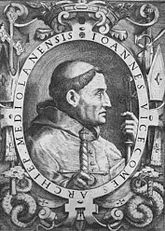Giovanni Visconti (archbishop of Milan)
Giovanni Visconti | |
|---|---|
| Lord of Milan and Pavia Archbishop of Milan | |
 | |
| Coat of arms |  |
| Born | 1290 |
| Died | 1354 |
| Buried | 1354 Milan Cathedral |
| Noble family | House of Visconti |
| Father | Matteo I Visconti |
| Mother | Bonacossa Borri |
| Occupation | Cardinal |
Giovanni Visconti (1290–1354) was an Italian Roman Catholic cardinal, who was co-ruler in Milan and lord of other Italian cities.[1][2] He also was a military leader who fought against Florence, and used force to capture and hold other cities.[3]
Biography[edit]
He was the son of Matteo I Visconti and Bonacossa Borri.
Giovanni Visconti was elected archbishop by the Capitol of Milan in 1317, but Pope John XXII refused to confirm the election and instead raised Aicardus from Comodeia to that position.[2] In 1323 John excommunicated him with an accusation of heresy, and Visconti found an ally in the antipope Nicholas V,[2] who give him the title of cardinal. In 1331 he became bishop and lord of Novara,[1] and in 1339, after Aicardus' death, he triumphantly entered Milan, although Pope Clement VI only issued a bull confirming him in the archbishopric in 1342.[2] Officially, he was Archbishop of Milan from 1342 to 1354.[4]
Together with his brother Luchino, Visconti bought from the Pope the title of co-ruler of Milan, for 500,000 florins.[2] After Luchino's death, he associated in the lordship the sons of his other brother, Stefano, who were Matteo II, Bernabò and Galeazzo II.[2]
The year after Luchino Visconti's death in 1349, and with the approval of his relations, Giovanni Visconti assumed full lordship of Milan and began consolidating power in Lombardy and beyond. The same year, 1350, he obtained lordship over Bologna and placed his nephew, Bernabò, in charge of the city in 1351.[3]
Afraid of his growing strength, in 1350 Florence organized a conference in Arezzo with a papal legate and representatives of other cities to form an alliance against Milan. Aware of these moves against him, Giovanni Visconti cultivated affection and alliance with the Ghibellines of Tuscany and Romagna. After the death of Mastino II della Scala of Verona, who had been hostile to the Archbishop, he gained the friendship of Mastino's son, Cangrande II della Scala.[3]
In 1351, he sent troops from Milan and Bologna, and from allies in Faenza and Forlì, all led by Bernabò, to lay siege to Imola. With war occurring in the Romagna region, Giovanni Visconti was able to lull the Florentines into believing that he had no intentions towards them. However, he then had many leading Bolognese citizens arrested and tortured, and extracted confessions from them of a conspiracy with Florence to overthrow his rule. He used this as a justification for war against Florence and the Guelphs of Tuscany. The Archbishop placed Giovanni da Oleggio, another Visconti, in command, and he amassed an army from Bologna and led them into Tuscany to besiege and capture towns and castles, while Ghibelline allies in Tuscany wreaked havoc elsewhere in the region.[3]
In 1352, Giovanni Visconti became lord of Genoa, and in the following year, he added Novara.[2] In 1353, Petrarch visited as his guest.[5]
Giovanni Visconti died 5 October 1354.[1]
Gallery[edit]
-
The House of Visconti coat of arms on the Archbishops' palace in Piazza Duomo bearing the initials (IO.<HANNES>) of the name of Archbishop Giovanni Visconti.
-
Giovanni Visconti's tomb. The shared grave of Archbishops Ottone Visconti († 1295) and Giovanni Visconti is preserved inside the Milan Cathedral, Italy. It was sculpted by an anonymous Campionese master, and it originally stood in Santa Tecla church. A Latin poem is sculpted on it, signed by a Sabino de' Zamorei from Parma and dated 1354.
Ancestry[edit]
| Ancestors of Giovanni Visconti (archbishop of Milan) | ||||||||||||||||||||||||||||||||||||||||||||||||||||||||||||||||||||||||||||||||||||||||||||||||||||||||||||||||||||||||||||||||||||||||||||||||||||||||||||||||||||||||||||||||||||||||||||||||||||||||||||||||||||||||||||||||||||||||||||||||||||||||||||||||||||||||||||||||||||||||||||||||||||||||||||||||||||||||||||||||||||||||||||||||||||||||||||||||||||||||||||||||||||||||||||||||||||||||||||||||||||||||||||||||||||||||||||||||||||||||||||||||||||||||||||||||||||||||||||||||||||||||||||||||||||||||||||||||||||||||||||||||||||||||||||||||||||||||||||||||||||||||||||||||||||||||||||||||
|---|---|---|---|---|---|---|---|---|---|---|---|---|---|---|---|---|---|---|---|---|---|---|---|---|---|---|---|---|---|---|---|---|---|---|---|---|---|---|---|---|---|---|---|---|---|---|---|---|---|---|---|---|---|---|---|---|---|---|---|---|---|---|---|---|---|---|---|---|---|---|---|---|---|---|---|---|---|---|---|---|---|---|---|---|---|---|---|---|---|---|---|---|---|---|---|---|---|---|---|---|---|---|---|---|---|---|---|---|---|---|---|---|---|---|---|---|---|---|---|---|---|---|---|---|---|---|---|---|---|---|---|---|---|---|---|---|---|---|---|---|---|---|---|---|---|---|---|---|---|---|---|---|---|---|---|---|---|---|---|---|---|---|---|---|---|---|---|---|---|---|---|---|---|---|---|---|---|---|---|---|---|---|---|---|---|---|---|---|---|---|---|---|---|---|---|---|---|---|---|---|---|---|---|---|---|---|---|---|---|---|---|---|---|---|---|---|---|---|---|---|---|---|---|---|---|---|---|---|---|---|---|---|---|---|---|---|---|---|---|---|---|---|---|---|---|---|---|---|---|---|---|---|---|---|---|---|---|---|---|---|---|---|---|---|---|---|---|---|---|---|---|---|---|---|---|---|---|---|---|---|---|---|---|---|---|---|---|---|---|---|---|---|---|---|---|---|---|---|---|---|---|---|---|---|---|---|---|---|---|---|---|---|---|---|---|---|---|---|---|---|---|---|---|---|---|---|---|---|---|---|---|---|---|---|---|---|---|---|---|---|---|---|---|---|---|---|---|---|---|---|---|---|---|---|---|---|---|---|---|---|---|---|---|---|---|---|---|---|---|---|---|---|---|---|---|---|---|---|---|---|---|---|---|---|---|---|---|---|---|---|---|---|---|---|---|---|---|---|---|---|---|---|---|---|---|---|---|---|---|---|---|---|---|---|---|---|---|---|---|---|---|---|---|---|---|---|---|---|---|---|---|---|---|---|---|---|---|---|---|---|---|---|---|---|---|---|---|---|---|---|---|---|---|---|---|---|---|---|---|---|---|---|---|---|---|---|---|---|---|---|---|---|---|---|---|---|---|---|---|---|---|---|---|---|---|---|---|---|---|---|---|---|---|---|---|---|---|---|---|---|---|---|---|---|---|---|---|---|---|---|---|---|---|---|---|---|---|---|---|---|---|---|---|---|---|---|---|---|---|---|---|---|---|---|---|---|---|---|---|---|---|---|---|---|---|---|---|---|---|---|---|---|---|---|---|---|---|---|---|---|---|---|---|---|---|---|---|---|---|---|---|---|---|---|---|---|---|---|---|---|---|---|---|---|---|---|---|---|---|---|---|---|
| ||||||||||||||||||||||||||||||||||||||||||||||||||||||||||||||||||||||||||||||||||||||||||||||||||||||||||||||||||||||||||||||||||||||||||||||||||||||||||||||||||||||||||||||||||||||||||||||||||||||||||||||||||||||||||||||||||||||||||||||||||||||||||||||||||||||||||||||||||||||||||||||||||||||||||||||||||||||||||||||||||||||||||||||||||||||||||||||||||||||||||||||||||||||||||||||||||||||||||||||||||||||||||||||||||||||||||||||||||||||||||||||||||||||||||||||||||||||||||||||||||||||||||||||||||||||||||||||||||||||||||||||||||||||||||||||||||||||||||||||||||||||||||||||||||||||||||||||||
References[edit]
- ^ a b c Simeoni, Luigi (1937). "VISCONTI, Giovanni". Enciclopedia Italiana (in Italian). Retrieved October 3, 2018.
- ^ a b c d e f g Tolfo, Maria Grazia; Colussi, Paolo (February 7, 2006). "Storia di Milano ::: I Visconti" [History of Milan::: The Visconti]. Storia di Milano (in Italian). Milano: Storiadimilano. Retrieved July 25, 2010.
- ^ a b c d Bruni, Leonardo (2004). Hankins, James (ed.). History of the Florentine people. I Tatti Renaissance library (in Latin and English). Vol. 2, Books 5-8. Cambridge, MA, USA ; London: Harvard University Press. ISBN 978-0-674-01066-6. OCLC 75180629.
- ^ Cadili, Alberto (2007). Giovanni Visconti, arcivescovo di Milano, 1342-1354 [Giovanni Visconti, Archbishop of Milan, 1342-1354]. Studi di storia del cristianesimo e delle chiese cristiane (in Italian). Milano: Ed. Biblioteca francescana. OCLC 608151505.
- ^ Kleinhenz, Christopher, ed. (2004). "MILAN". Medieval Italy: an encyclopedia. Routledge encyclopedias of the Middle Ages, vol. 9. Vol. 2, L to Z, Index. associate ed. John W. Barker, Gail Geiger, Richard Lansing. New York: Routledge. p. 712, Column 2. ISBN 9780415939317. OCLC 469725245. Retrieved July 26, 2010.



